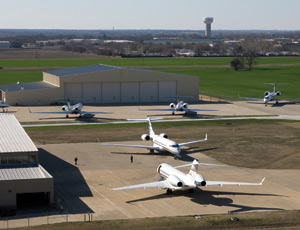Construction starts this month on a new flight control tower as part of a $71-million capital improvement program that began in 2002 to improve infrastructure needs at the Collin County Regional Airport in McKinney.

The CCRA plans to break ground this month on the new tower. At press time, the contract for the project had not been awarded.
The general aviation airport opened 30 years ago, and now has more than 20,000 visitors arriving at the airport each year. It caters to private aviation with a niche for accommodating upscale business aircraft.
“We are the only business-class airport in Collin County,” Ken Wiegand, executive director for the McKinney Airport Development Corp., told Texas Construction. “Because of the number of corporate headquarters and the fact that Collin County is one of the richest counties in the state, we know the demand will grow.”
The CCRA started with a 4,000-ft runway and now has a 7,000-ft runway. As part of a master plan, about 100 acres of land to add to the airport were purchased. Three new taxilanes will be planed on that land.
“While a runway is like an interstate highway, a taxiway is like the access road and taxilanes are like avenues and streets to get to places,” Wiegand says.
While the runway and taxiways meet federal standards, Wiegand says airport officials believe they are too close together to support large aircraft.
“We planned and got funding to make improvements. We will have a replacement runway that will take the place of the runway we just rehabilitated. It is a three-year project with a $57-million price tag,” Wiegand said.
It marks the largest single aviation project Texas Department of Transportation has ever initiated, he adds. The city and its funding agencies put up $7 million to make the runway wider than federal government requirements. Doing so now will save money down the road, he says. The runway will be able to accommodate larger aircraft when completed in 2012.
“We believe the new runway will attract a lot of attention from the community and operators,” he says. “It will meet the commercial standard of being 150-ft wide, 7,000-ft long as well as a 1,000-ft extension in the future, at least.”
About two years ago, the airport finished a $6-million rehabilitation “white-topping” project.
“We found that over time the larger aircrafts operating off our runway were deteriorating the surface pretty badly,” Wiegand says. “We put 13 in. of concrete over a repaired asphalt runway and what we have today is a modern runway that can handle a Boeing 737.”
He says that doing the overlay “saved millions of dollars in reconstruction” because there is no need to “go back in and tear out the runway and completely rebuild from scratch. The project also came in under budget and on time.”
White-topping has only been done to one other general aviation airport in Texas to date, he adds.


Post a comment to this article
Report Abusive Comment